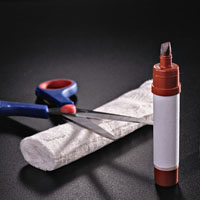Macrophage supernatant infected with Leishmania major mediates the cytology of fibroblast cells in skin wounds

Submitted: 29 May 2020
Accepted: 12 October 2020
Published: 2 December 2020
Accepted: 12 October 2020
Abstract Views: 442
PDF: 314
Publisher's note
All claims expressed in this article are solely those of the authors and do not necessarily represent those of their affiliated organizations, or those of the publisher, the editors and the reviewers. Any product that may be evaluated in this article or claim that may be made by its manufacturer is not guaranteed or endorsed by the publisher.
All claims expressed in this article are solely those of the authors and do not necessarily represent those of their affiliated organizations, or those of the publisher, the editors and the reviewers. Any product that may be evaluated in this article or claim that may be made by its manufacturer is not guaranteed or endorsed by the publisher.
Similar Articles
- Md. Riaz Hossain, Md. Sifat Foysal, Jannatul Naima, Sadab Sipar Ibban, Evaluation of antioxidant and neuropharmacological properties of Leea aequata leaves , Infectious Diseases and Herbal Medicine: Vol. 5 (2024)
- Harish Gugnani, Dermatophytes, dermatophytosis in the Caribbean and potential for herbal therapy , Infectious Diseases and Herbal Medicine: Vol. 1 (2020)
- Muhammad Awwal Tijjani, Mohammed Garba Magaji, Abdullahi Hamza Yaro, Hamidu Usman, Aishatu Muhammad, Sani Sa'idu Bello, Chinwe Euphemia Egwu, Zainab Mohammed Chellube, Behavioural studies on crude Ethanol leaf extract of Cadaba farinosa Forssk. in mice , Infectious Diseases and Herbal Medicine: Vol. 3 (2022)
- Siukan Law, Licorice and its applications for SARS-CoV-2 , Infectious Diseases and Herbal Medicine: Vol. 3 (2022)
- Kudzai Fambisai, Petros Muchesa, Farisai Chidzwondo, Rumbidzai Mangoyi, Anti-amoebic effects of selected herbal extracts against Acanthamoeba species isolated from different borehole water samples from Budiriro District in Harare, Zimbabwe , Infectious Diseases and Herbal Medicine: Vol. 5 (2024)
You may also start an advanced similarity search for this article.

 https://doi.org/10.4081/idhm.2020.83
https://doi.org/10.4081/idhm.2020.83



